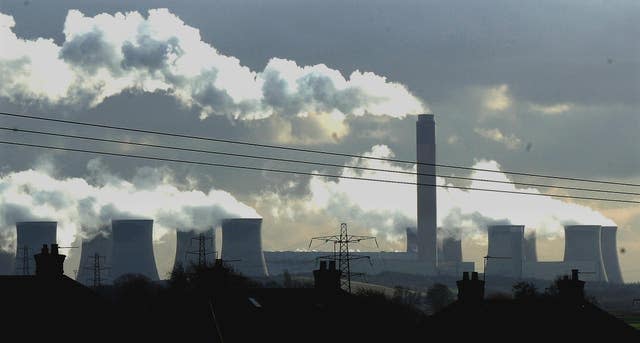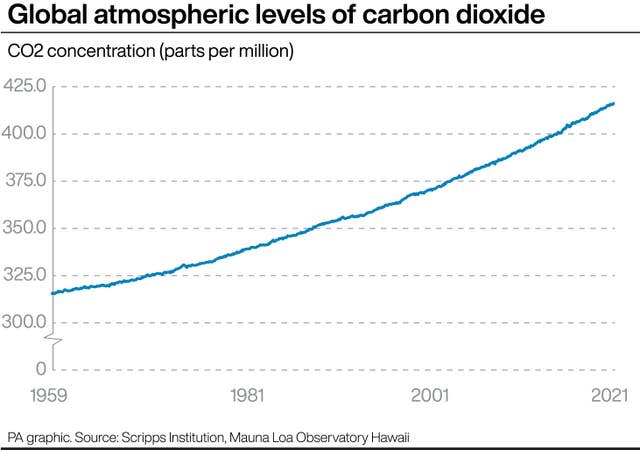The long road to Cop26: history of the science and fight against climate chaos
When world leaders gather in Glasgow for Cop26 in a bid to curb dangerous warming, it will be in the face of code red scientific warnings of climate change and urgent calls for action.
But the latest update to the Oxford English Dictionary shows we have been talking about “climate change” for more than a century and a half, so how did we get here and why has it taken so long?
Here are some key milestones in the history of climate change:
– James Watt patented his steam engine in 1769, helping drive the Industrial Revolution and its use of fossil fuels.
– Joseph Fourier recognised the atmosphere acts as a blanket, keeping the Earth warmer than it would otherwise be, the “greenhouse effect”, as early as 1824.
– Just a few decades later Irish physicist John Tyndall measured the absorption of heat by greenhouse gases including carbon dioxide in his laboratory in London, publishing a paper on his findings in 1861.
A few years before him American female scientist Eunice Newton Foote conducted an experiment revealing the heat-trapping properties of carbon dioxide, and warned in a scientific paper in 1856 that an atmosphere of that gas would give the Earth a high temperature.
– Before the end of the 19th century – which saw the development of ocean-going steamships, coal fired power stations for electricity and the motor car – scientists began to spell out the impact of changing carbon dioxide levels.
In 1896 Svante Arrhenius published a paper on ice ages which estimated temperature changes due to changing carbon dioxide in the atmosphere.
He was followed a few years later by fellow Swede Nils Ekholm suggesting the gas could increase in the atmosphere over the coming millennium due to the burning of coal, which would warm the Earth.

– In 1938 Guy Callendar, an amateur meteorologist who collected and combined thousands of observations of temperature and carbon dioxide from around the world, was the first to show that human-caused emissions of carbon dioxide were contributing to rising global temperatures.
He did the calculations in his spare time, without a computer.
– Oceanographer Roger Revelle first briefed the US Congress on climate change in 1956, warning that “we are making perhaps the greatest geophysical experiment in history”.
Shortly afterwards, Charles David Keeling started measuring carbon dioxide at the Mauna Loa Observatory in Hawaii, producing the “Keeling Curve” – a clear record of rising CO2 levels in the atmosphere
Two decades later Nasa scientist James Hansen’s testimony to Congress in 1988 was front page news: he told a Senate committee that global warming was “already happening now” and was almost certainly not due to natural variation.
– The Intergovernmental Panel on Climate Change (IPCC) was established by the UN at the end of that year, to prepare a comprehensive review of the state of knowledge of the science of climate change and its impacts.
We are now in the sixth assessment cycle that the IPCC has conducted, which issued a “code red” for humanity this summer.

– In the late 1980s there were growing calls for an international treaty on climate change, not least as countries had just managed to successfully negotiate the Montreal Protocol to phase down the use of CFC chemicals that were damaging the ozone layer, another major environment problem.
Among those making the calls was UK prime minister Margaret Thatcher, who warned of the threat of climate change in a speech to the UN in 1989.
– The treaty, known as the United Nations Framework Convention on Climate Change (UNFCCC), was agreed at the Rio Earth Summit in 1992.
– The first Cop – or “conference of parties” to the UNFCCC – in 1995, presided over by Angela Merkel, got the show on the road towards a deal to take action on the greenhouse gas emissions driving climate change.
– The world’s first climate change treaty, the Kyoto Protocol, was
agreed in 1997, with developed nations committing to cuts to their emissions.
It entered into force in 2005, but was never ratified by the United States and did not cover the burgeoning emissions of emerging economies such as China.
– Talks in Copenhagen in 2009 to secure a new treaty did not go as planned, against a backdrop of the financial crisis, acrimony between countries and efforts by climate sceptics to cast doubt on the science, and failed to secure the comprehensive deal it was now clear was needed.
– Countries finally secured the Paris Agreement in 2015 in the French capital, agreeing a comprehensive global deal to limit temperature rises to well below 2C above pre-industrial levels and to pursuing efforts to curb warming to 1.5C.
Another six years on, countries meeting in Glasgow for Cop26 are being urged to deliver on the promises they made in Paris and drive the action needed to curb dangerous warming.
Climate campaigner and author of Our Biggest Experiment, a history of the climate crisis, Alice Bell, said that the world was still talking about delivering action three decades after the first calls for action in part because the oil industry pushed back with successful tactics for delay.
Also, she said, climate diplomacy takes time, adding: “The architects of the UNFCCC knew that in 1992, which is one of the reasons why they didn’t just make an agreement but agreed to meet every year to keep making that agreement, and trying to make it better.”
But she said people would be “forgiven for thinking this has just offered an opportunity for generations of politicians to keep on chatting rather than actually doing anything.
“We’ve been talking about climate change for well over 150 years, and worried about it for a good 50. It’s time to get to work.”


